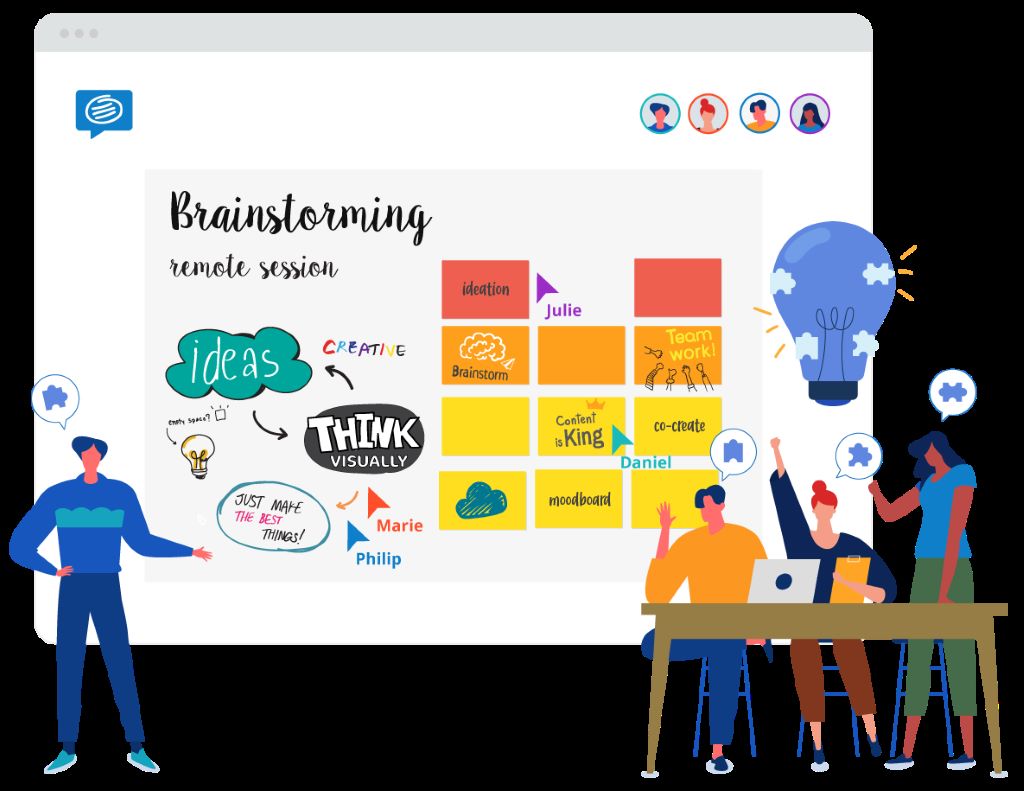Initiating the process of brainstorming for new business ideas can be both invigorating and challenging. It is an essential step for entrepreneurs and businesses aspiring to innovate or venture into new markets. One must gather a deep understanding of target markets, current trends, and customer pain points to harness creativity effectively.
Aligning personal interests and skill sets with market needs often leads to the most viable and passionate business concepts. Utilizing brainstorming techniques such as mind mapping, brainstorming sessions with diverse teams, and iterative feedback can facilitate the generation of a multitude of ideas. Each idea should then be rigorously evaluated for feasibility, market potential, and alignment with business objectives. By cultivating a fertile environment for idea generation and committing to continuous idea refinement, entrepreneurs can turn a spark of inspiration into a successful business venture.
Setting The Stage For Innovation
When embarking on the thrilling journey of business ideation, beginning with a fertile ground for innovation is crucial. It’s not just about having great ideas; it’s about nurturing an atmosphere where creativity blossoms. Let’s delve into how we can set the stage for innovation and turn the seed of an idea into a forest of possibilities.
Creating A Conducive Environment
Imagine a workspace that breathes inspiration. The ambiance, the sounds, and the surroundings can all play a pivotal role in stirring the creative psyche. Start by selecting a quiet space, free from distractions. Ensure there’s ample light, comfortable seating, and access to resources like whiteboards, sticky notes, or digital tools for capturing thoughts spontaneously.
- Comfortable, ergonomically designed furniture for long sessions
- Natural lighting paired with vibrant colors stimulates the mind
- Easy accessibility to tools for ideation (e.g., mind mapping software)
Assembling A Diverse Team
Great ideas often come from cross-pollination between different minds. When putting together a team, aim for diversity in all aspects: skillset, experience, background, and thought process. This variety ensures new perspectives and avoids echo chambers. Every member should feel valued and empowered to speak up.
| Aspect | Why It Matters |
| Skills | Versatile skills bring unique solutions. |
| Experience | Varied experiences foster well-rounded ideas. |
| Background | Diverse backgrounds promote rich insights. |
| Personality | Different personalities ensure dynamic interactions. |
Techniques To Spark Creativity
In the quest to unearth groundbreaking business ideas, creativity stands as the indefatigable engine. Transforming a vague notion into a lucid, potentially lucrative business concept demands systematic creativity techniques. By tapping into several structured methods, individuals and teams can foster an environment ripe for innovation.
Mind Mapping For Structured Ideation
Mind mapping serves as a visual tool that aids in the organization of thoughts and ideas. Starting with a central concept, this technique branches out into subtopics, creating a diagram that mirrors the way the brain works.
- Begin with a central idea or problem.
- Draw branches to represent different aspects or solutions.
- Use colors and images to enhance memory and inspiration.
- Connect related subtopics to weave a comprehensive web of ideas.
Brainwriting And Rapid Ideation Exercises
Brainwriting accelerates the generation of ideas by having participants independently write down their thoughts before sharing them. This approach encourages participation from all group members, giving life to a diverse array of ideas.
- Everyone writes their ideas on paper for a set time.
- Papers are passed around for others to build on the ideas presented.
- The process is repeated until a robust collection of ideas is developed.
- Groups discuss the ideas to identify the most promising ones.
Rapid ideation is a time-constrained exercise that forces quick thinking.
- Set a timer (usually 5-10 minutes).
- Jot down as many ideas as possible within the time limit.
- Review and refine the list later to find viable options.
Employing Reverse Brainstorming
With reverse brainstorming, creativity is sparked by turning the problem on its head. This method prompts thinking outside the box.
- Identify a problem or challenge.
- Reverse the problem to look at it from a different angle.
- Brainstorm solutions for this ‘reversed’ problem.
- Reverse these solutions back into positive ideas for the original problem.
Harnessing Everyday Problems For Opportunities
When obstacles arise, savvy entrepreneurs see windows of possibility. This concept revolves around turning stumbling blocks into stepping stones. Let’s delve into how everyday issues can unfold into business ideas.
Finding Inspiration In Daily Life
Observe the world around you. Problems are not just frustrations; they are untapped markets. Take note of common complaints you hear in daily conversations, be it in a coffee shop or online forums. These are potential ideas screaming for solutions.
- Spot inefficient processes at work or in public spaces.
- Identify products or services that don’t meet your standards.
- Consider what tasks people would pay to avoid.
Keep a journal or use a digital app to record observations. Regularly reviewing this journal could reveal patterns and opportunities for innovation.
Turning Hobbies Into Business Ventures
Passions are not just for leisure; they can bloom into profitable ventures. Scout your hobbies for commercial potential. Here’s how you can transform a pastime into a paycheck.
| Hobby | Business Idea |
| Photography | Offer photo editing services or photography classes. |
| Baking | Start a custom cake business or baking blog. |
| Gardening | Design a line of eco-friendly gardening tools. |
Assess your hobby’s market demand, competition level, and monetization avenues like online sales or local fairs.
Leveraging Trends And Market Analysis
When brainstorming business ideas, it’s crucial to play off of the latest trends and conduct a thorough market analysis. This approach ensures that your idea is not only innovative but also in tune with what consumers demand. In the following sections, we dive into ways to dissect current market trends and perform an insightful SWOT analysis.
Analyzing Current Market Trends
Staying ahead of market trends is essential for any business idea to take flight. Here’s how you can analyze them effectively:
- Follow industry news and updates using tools like Google Trends.
- Attend trade shows and webinars related to your area of interest.
- Engage with social media to understand what’s creating buzz.
Identifying patterns in consumer behavior can give your business idea the edge it needs to succeed.
Performing A Swot Analysis
To assess your business idea’s potential, a SWOT analysis can be incredibly beneficial. Tackle this analysis by:
| Strengths | Weaknesses | Opportunities | Threats |
| What sets your idea apart? Look for unique selling points. | What limitations exist? Assess any hurdles your idea may face. | Perfect timing? Look for current trends that align with your idea. | Knowing competitors. Understand what obstacles they may pose. |
Dissecting these aspects can highlight both the rewards and risks associated with your business idea.
Transforming Quantity Into Quality
Brainstorming for business ideas often starts with a burst of quantity. The true challenge lies in sifting through these ideas to uncover the golden nuggets of quality. In this journey from quantity to quality, the aim is not just to have numerous ideas but to refine and enhance them into viable business concepts. If you’re specifically interested in the food industry, consider exploring profitable food business ideas to ensure the transition from quantity to quality in your entrepreneurial endeavors.
Navigating Ideation Sessions For Valuable Ideas
Effective ideation sessions are key to converting raw ideas into valuable opportunities. Organize sessions with diverse thinkers. Encourage a free flow of thoughts. Capture everything. Here’s a guide:
- Set clear objectives: Define what you hope to achieve with your ideation session.
- Use visual aids: Mind maps and whiteboards can help visualize relationships between ideas.
- Time-box the session: Limit sessions to keep the energy high and focused.
- Build on ideas: Encourage participants to add to or combine the ideas of others.
Filtering And Refining The Idea Pool
Once you have a pool of ideas, the next step is to filter and refine. Focus on feasibility, scalability, and market potential. Here are some steps to guide the process:
- Evaluate the needs: Ensure each idea addresses a real customer need.
- Assess resources: Can you realistically bring the idea to life with your resources?
- Market research: Investigate the market demand for the proposed solutions.
- Solicit feedback: Present your ideas to a trusted group for their input.
By thoroughly implementing these strategies, you transform a quantity of raw, untested ideas into a quality selection ripe for business success.
Collaboration And Feedback
Seeking collaboration and soliciting feedback are vital steps in brainstorming business ideas. Through shared expertise and different perspectives, you can refine your ideas and ensure they have real-world appeal.
Creating feedback loops
Creating Feedback Loops
Feedback loops keep the brainstorming process dynamic and informative. Regular check-ins with your team help to assess progress and incorporate new insights.
- Set up regular meetings to share ideas.
- Use digital tools for ongoing communication.
- Adjust strategies based on team input.
Validating ideas with potential customers
Validating Ideas With Potential Customers
Understanding customer needs directly affects your idea’s success. Validation ensures your concept has a market demand.
- Conduct surveys to gather customer opinions.
- Run focus groups to delve deeper into customer needs.
- Prototype your idea and seek testimonials.
Frequently Asked Questions On How To Brainstorm Business Ideas
How Do You Brainstorm A Good Business Idea?
Identify problems needing solutions and envision innovative fixes. Analyze market gaps and explore potential fills. Engage in mind mapping to link related concepts. Discuss with peers for diverse insights and improvements. Reflect on personal passions to inspire viable ventures.
How Do I Start Thinking About Business Ideas?
Begin by identifying problems you’d like to solve. Explore your skills and passions for potential business concepts. Research market gaps and emerging trends for inspiration. Engage with potential customers to understand their needs. Test ideas through small-scale experiments or prototypes.
What Are The 6 Creative Ways To Brainstorm?
- Use mind mapping to explore related ideas.
- Engage in brainwriting for silent idea generation.
- Try reverse brainstorming to solve problems creatively.
- Organize a rapid ideation session for quick-fire thoughts.
- Implement the star bursting technique to ask crucial questions.
- Conduct a SWOT analysis to evaluate strengths, weaknesses, opportunities, and threats.
How To Develop Business Ideas?
Identify problems you encounter daily and brainstorm solutions. Research market gaps and trends to inspire innovative ideas. Utilize your skills and passions to create a business concept. Conduct a SWOT analysis to evaluate potential and challenges. Engage with your network for diverse perspectives and validation.
Conclusion
Embarking on the quest for the next great business idea can seem daunting. Yet, the brainstorming strategies discussed offer a clear path. Harness creativity, tap into personal passions, and observe day-to-day challenges. These steps are the seeds of innovation, awaiting your nurturing to grow into successful ventures.
Exploring the advantages and disadvantages of an outdoor space rental business, it’s crucial to remember to think outside the box, refine your thoughts, and engage with others for diverse perspectives. Your groundbreaking business idea is within reach; it only awaits your initiative to bring it to life. Keep exploring, questioning, and connecting—the possibilities are endless, and with careful consideration of both the benefits and challenges, you can turn this concept into a thriving reality.






